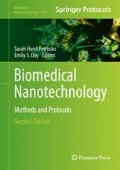Abstract
The hydrogel template strategy was previously developed to fabricate homogeneous polymeric microparticles. Here, we demonstrate the versatility of the hydrogel template strategy for the development of nanowafer-based ocular drug delivery systems. We describe the fabrication of dexamethasone-loaded nanowafers using polyvinyl alcohol and the instillation of a nanowafer on a mouse eye. The nanowafer, a small circular disk, is placed on the ocular surface, and it releases a drug as it slowly dissolves over time, thus increasing ocular bioavailability and enhancing efficiency to treat eye injuries.
Access this chapter
Tax calculation will be finalised at checkout
Purchases are for personal use only
References
Urtti A (2006) Challenges and obstacles of ocular pharmacokinetics and drug delivery. Adv Drug Deliv Rev 58:1131–1135
Novack GD (2009) Ophthalmic drug delivery: development and regulatory considerations. Clin Pharmacol Ther 85:539–543
Kim YC, Chiang B, Wu X et al (2014) Ocular delivery of macromolecules. J Control Release 190:172–181
Gaudana R, Ananthula HK, Parenky A et al (2010) Ocular drug delivery. Am Assoc Pharm Sci J 12:348–360
Ranta VP, Urtti A (2006) Transscleral drug delivery to the posterior eye: prospects of pharmacokinetic modeling. Adv Drug Deliv Rev 58:1164–1181
Mannermaa E, Vellonen KS, Urtti A (2006) Drug transport in corneal epithelium and blood_retina barrier: emerging role of transporters in ocular pharmacokinetics. Adv Drug Deliv Rev 58:1136–1163
Jarvinen K, Jarvinen T, Urtti A (1995) Ocular absorption following topical delivery. Adv Drug Deliv Rev 16:3–19
Salminen L (1990) Review: systemic absorption of topically applied ocular drugs in humans. J Ocul Pharmacol 6:243–249
Diebold Y, Calonge M (2010) Applications of nanoparticles in ophthalmology. Prog Retina Eye Res 29:596–609
Gershkovich P, Wasan KM, Barta CA (2008) A review of the application of lipid-based systems in systemic, dermal, transdermal, and ocular drug delivery. Crit Rev Ther Drug 25:545–584
Choy YB, Park JH, McCarey BE et al (2008) Mucoadhesive microdiscs engineered for ophthalmic drug delivery: effect of particle geometry and formulation on preocular residence time. Invest Ophthalmol Vis Sci 49:4808–4815
Chang E, McClellan AJ, Farley WJ et al (2011) Biodegradable PLGA-based drug delivery systems for modulating ocular surface disease under experimental murine dry eye. J Clin Exp Ophthalmol 2:191. doi:10.4172/2155-9570.1000191
Aksungur P, Demirbilek M, Denkbas EB et al (2011) Development and characterization of cyclosporine a loaded nanoparticles for ocular drug delivery: cellular toxicity, uptake, and kinetic studies. J Control Release 151:286–294
Shah M, Edman MC, Janga SR et al (2013) A rapamycin-binding protein polymer nanoparticle shows potent therapeutic activity in suppressing autoimmune dacryoadenitis in a mouse model of Sjogren's syndrome. J Control Release 171:269–279
Gulsen D, Chauhan A (2004) Ophthalmic drug delivery through contact lenses. Invest Ophthalmol Vis Sci 45:2342–2347
Carvalho IM, Marques CS, Oliveira RS et al (2015) Sustained drug release by contact lenses for glaucoma treatment–a review. J Control Release 202:76–82
Garhwal R, Shady SF, Ellis EJ et al (2012) Sustained ocular delivery of ciprofloxacin using nanospheres and conventional contact lens materials. Invest Ophthalmol Vis Sci 53:1341–1352
Singh K, Nair AB, Kumar A et al (2011) Novel approaches in formulation and drug delivery using contact lenses. J Basic Clin Pharm 2:87–101
Acharya G, Shin CS, McDermott M et al (2010) The hydrogel template method for fabrication of homogeneous nano/micro particles. J Control Release 141:314–319
Acharya G, Shin CS, Vedantham K et al (2010) A study of drug release from homogeneous PLGA microstructures. J Control Release 146:201–206
Acharya G, McDermott M, Shin SJ et al (2011) Hydrogel templates for the fabrication of homogeneous polymer microparticles. Methods Mol Biol 726:179–185
Coursey TG, Henriksson JT, Marcano DC et al (2015) Dexamethasone nanowafer as an effective therapy for dry eye disease. J Control Release 213:168–174
Yuan X, Marcano DC, Shin CS et al (2015) Ocular drug delivery nanowafer with enhanced therapeutic efficacy. ACS Nano 9:1749–1758
Ludwig A (2005) The use of mucoadhesive polymers in ocular drug delivery. Adv Drug Deliv Rev 57:1595–1639
Moshirfar M, Pierson K, Hanamaikai K et al (2014) Artificial tears potpourri: a literature review. Clin Ophthalmol 8:1419–1433
Nagelhout TJ, Gamache DA, Roberts L et al (2005) Preservation of tear film integrity and inhibition of corneal injury by dexamethasone in a rabbit model of lacrimal gland inflammation-induced dry eye. J Ocul Pharmacol Ther 21:139–148
Patane MA, Cohen A, From S et al (2011) Ocular iontophoresis of EGP-437 (dexamethasone phosphate) in dry eye patients: results of a randomized clinical trial. Clin. Ophthalmol. 5:633–643
Author information
Authors and Affiliations
Corresponding author
Editor information
Editors and Affiliations
Rights and permissions
Copyright information
© 2017 Springer Science+Business Media LLC
About this protocol
Cite this protocol
Shin, C.S., Marcano, D.C., Park, K., Acharya, G. (2017). Application of Hydrogel Template Strategy in Ocular Drug Delivery. In: Petrosko, S., Day, E. (eds) Biomedical Nanotechnology. Methods in Molecular Biology, vol 1570. Humana Press, New York, NY. https://doi.org/10.1007/978-1-4939-6840-4_19
Download citation
DOI: https://doi.org/10.1007/978-1-4939-6840-4_19
Published:
Publisher Name: Humana Press, New York, NY
Print ISBN: 978-1-4939-6838-1
Online ISBN: 978-1-4939-6840-4
eBook Packages: Springer Protocols

